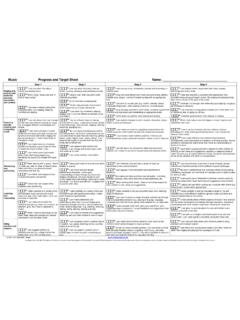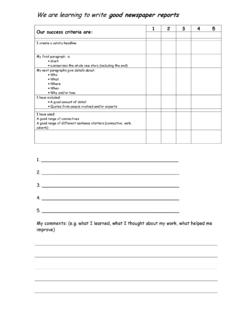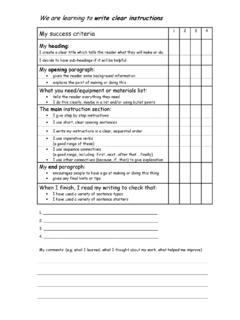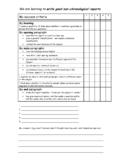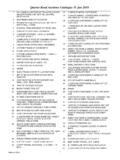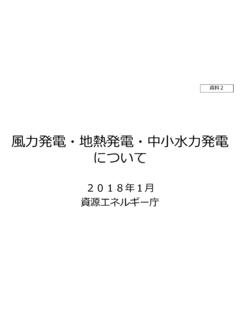Transcription of History Progress and Target Sheet Mastery Y5
1 Developed from Progression in History under the 2014 National Curriculum published by The Historical Association. Pupil Progress and Target statements and the document structure are provided under a Creative Commons Attribution-NonCommercial ShareAlike International Licence. History Year 5 Progress and Target Record Sheet Name: _____ Step 2 Step 3 Step 4 Step 5 Chronology, knowledge and understanding of History 2a I can describe some features, events, people and themes from the past 3a When I talk or write about features, events, people and themes from the past, I can include some details. 4a When I talk or write about the past, I include detail; I show that I can make some connections with features of other periods I have studied 5a When I talk or write about the past, I include detail; I include ideas which show some understanding of what things were like before and after this at local, national and world levels 2b I can sequence a few events, objects or pieces of information on a timeline 3b I can place events, objects, themes and people from my History topic on a timeline 4b I can place a number of events, objects, themes and people from topics I have studied on a timeline 5b I can place historical periods I have studied as well as information about my topic on a timeline 3c1 I can use some historical period terms.
2 3c2 I can also use century , decade , BC / BCE , AD / CE 3c1 I can use some historical period terms. 3c2 I can also use century , decade , BC / BCE , AD / CE 4c I can use some dates and historical period terms. 5c I use dates and historical period terms accurately Continuity and change (during and between periods) 2d I can point out some similarities and differences between aspects of my life and the life of people in the period I am learning about 3d I can point out some similarities and differences between aspects of life at different times in the past 4d I can describe some changes in the historical period I am studying 5d I can describe changes within and between periods and societies I have learned about Diversity (within a period) 2e I can point out some similarities and some differences between the ways of life different people living at the time I am learning about 3e I can describe some similarities and differences between people ( rich and poor)
3 , events and beliefs in the period of History I am studying 4e I can describe similarities and differences between some people, events and beliefs in the period of History I am studying 5e I can describe similarities and differences in society, culture and religion in Britain at local and national levels Cause and consequence 2f I can make some comments about why people did things, why events happened and what happened as a result 3f I can pick out some reasons for and results of people s actions and events 4f I can suggest reasons for and results of people s actions and events 5f I can give some reasons for and results of historical events, situations and changes Significance 3g I can point out which people were historically important 4g I can suggest which people were historically important 5g I can suggest which people and causes and consequences of change are more important Using & understanding sources of evidence 2h I can use information from more than one source in my answers 3h I can compare different sources of evidence about a person, object.
4 Event or change in History and point out some similarities and differences 4h I can comment on the usefulness and accuracy of different sources of evidence 5h I can suggest some reasons why there are different accounts and interpretations of the past Understanding historical interpretation 2i I can talk about some of the different ways that the past is recorded/represented [I can name some types of things which tell us about the past] 3i I can say which sources (from a selection) are likely to be the most useful for a task 4i I can identify primary and secondary sources of evidence 5i I compare sources of evidence to help me identify reliable information Communicating ideas in History 2j I can make labelled drawings, tables and write sentences, speak (including in drama) and use ICT to show my ideas 3j I can present my findings about past using my speaking, writing, maths (data handling), ICT, drama and drawing skills 4j In my written work, I try to: - organise my answers well - state my conclusions - give reasons for my ideas - use some dates and historical terms 5j My written answers are well rounded with: - well organised with clear conclusions - supported by evidence (from my sources) and reasons - make good use of dates and historical terms Developed from Progression in History under the 2014 National Curriculum published by The Historical Association.
5 Pupil Progress and Target statements and the document structure are provided under a Creative Commons Attribution-NonCommercial ShareAlike International Licence. Types of History sources I have used: Features of the past I have learned about include: houses and settlements culture and leisure activities clothes, tools and equipment way of life of men, women and children structure of society (leaders; rich and poor) buildings and their uses people s beliefs religion and attitudes things of importance to people work Other features I have studied: Name: _____ History Year 5 My History topics and projects: Developed from Progression in History under the 2014 National Curriculum published by The Historical Association. Pupil Progress and Target statements and the document structure are provided under a Creative Commons Attribution-NonCommercial ShareAlike International Licence.
6 Teachers notes The Progress and Target Sheet statements are, in large part, derived from the ideas recorded by Jamie Byrom in the Historical Association document Progression in History under the 2014 National Curriculum. I also considered the assessment/progression frameworks published by: Aycliffe Drive School and others ( ), Hiltingbury Junior School ( ) Rising Stars ( ) Warberry Primary School and Hornsea Community Primary School ( and ) Examples of types of sources of evidence which may be explored in History topics: artefacts, documents (see below), printed materials, the internet, databases, pictures, paintings, statues and other types of artwork, maps, photos, films, oral histories, music, artefacts, historic buildings and sites. Published documents include books, magazines, newspapers, government documents, non-government reports, literature of all kinds, advertisements, maps, pamphlets, posters, laws, and court decisions.
7 Unpublished documents include personal letters, diaries, journals, wills, deeds, family Bibles containing family histories, school report cards, and records such as correspondence, financial ledgers, information about customers, minutes of meetings.
